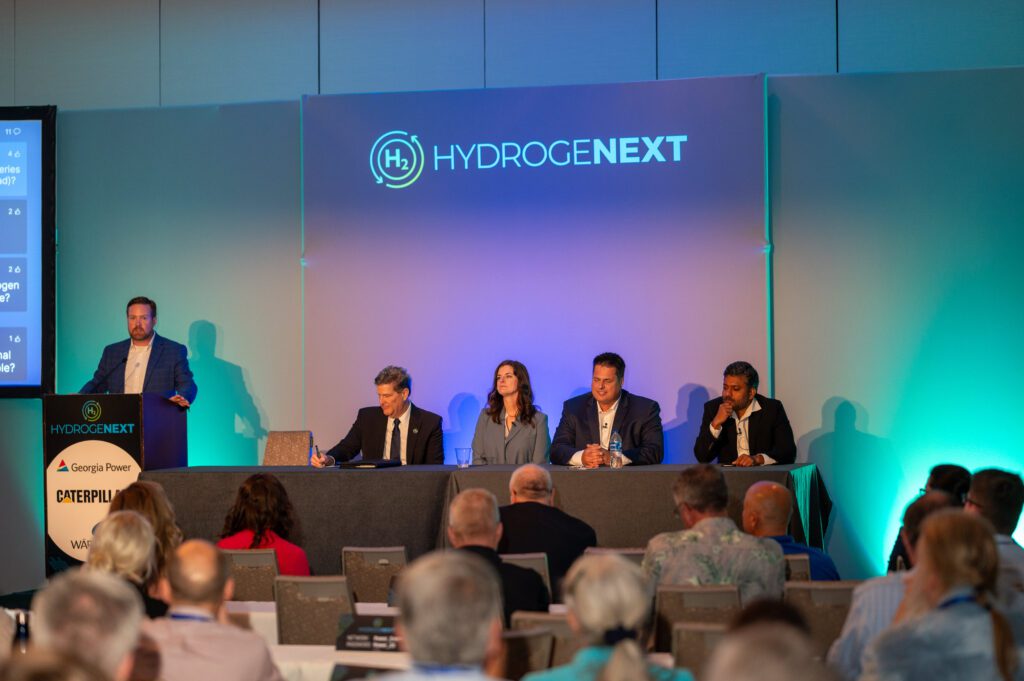Hydrogen is clearly one of the key drivers for decarbonizing industry and meeting crucial environmental objectives, as evidenced by the numerous announced projects and funding initiatives across the globe. This point was further underlined at the third annual HydrogeNext conference, part of Experience Power Week, presented by Chemical Engineering and POWER. The event covered ongoing hydrogen projects, production technologies, operational best practices and much more.

Experts from many different industry sectors came together to discuss the burgeoning Hydrogen Economy (Source: OMOS Photography)
Logistics, mobility and decarbonization
Experience Power Week keynote speaker Tim Echols, commissioner of the Georgia Public Service Commission, highlighted hydrogen as one of seven major trends in the energy world, emphasizing its importance in decarbonizing logistics and transport operations. “I really think the place to start with hydrogen fueling is in material-handling facilities. The low-hanging fruit for hydrogen use is forklifts, followed by Class 8 heavy-duty trucks,” he said. When compared to electrification for heavy-duty trucking, Echols points out several benefits hydrogen offers. “Vehicle batteries add weight, and with hydrogen you can refuel quickly and easily. With battery-electric trucks, you will have to sit and wait longer for charging.”
Another key point was hydrogen’s decarbonization synergy with nuclear power generation. In a session focused on financial metrics of hydrogen projects, Mike Kramer, vice president of growth and finance at Constellation Energy Corp. (Baltimore, Md.; www.constellation.com) outlined the economics of integrating hydrogen and nuclear, pointing out that electrolysis can be modularly ramped onto existing nuclear assets from the pilot stage through at-scale production, which allows iterative cost reductions and quick production scaleup for new off-takers. As an example of a successful deployment of nuclear hydrogen production, he detailed the Nine Mile Point nuclear plant in Oswego, N.Y., which started up a nuclear-powered hydrogen plant in March 2023.
Stabilizing the supply chain
As with any emergent technology, the production of “green” hydrogen via electrolysis comes with some uncertainty surrounding the supply chain and delivered costs. In a session covering supply-chain considerations for electrolyzers, Anthony DeOrsey, research manager for Cleantech Group (San Francisco, Calif.; www.cleantech.com) emphasized that precious metals, such as the iridium often used in electrolyzers, are not the only bottleneck in the electrolyzer supply chain. Seemingly more abundant, the nickel used in electrolyzers must also compete with growing demand from lithium-ion battery manufacturers. Supply-chain concerns notwithstanding, he also stated that the tax credits and other incentives brought about by last year’s Inflation Reduction Act (IRA) will help enable a “faster track to economies of scale for renewable hydrogen.”
The U.S. moves its hydrogen economy forward
Another highlight was a panel discussion on the regional Hydrogen Hubs in the U.S. vying for federal funding under the IRA. Representatives from four hubs discussed the unique benefits and challenges in implementing an overarching hydrogen economy in each particular region. The regional variation of industries served, as well as differences in production and transport infrastructure and workforce considerations, illustrate the many avenues that the hydrogen economy may take as more production capacity comes onstream. ■
 Mary Page Bailey, senior associate editor
Mary Page Bailey, senior associate editor